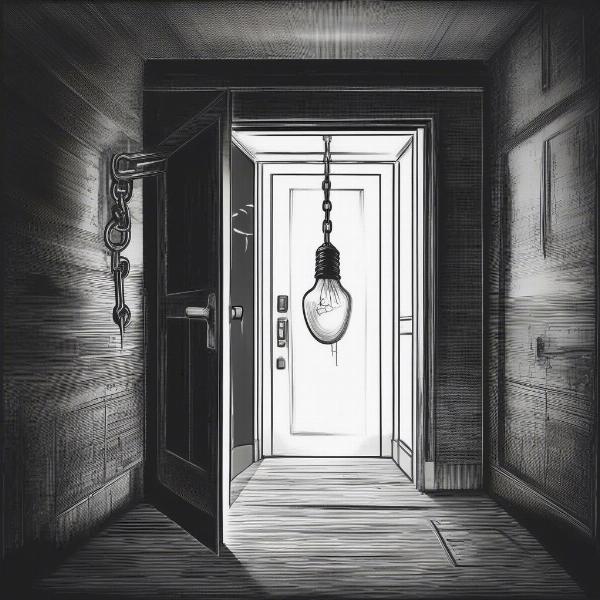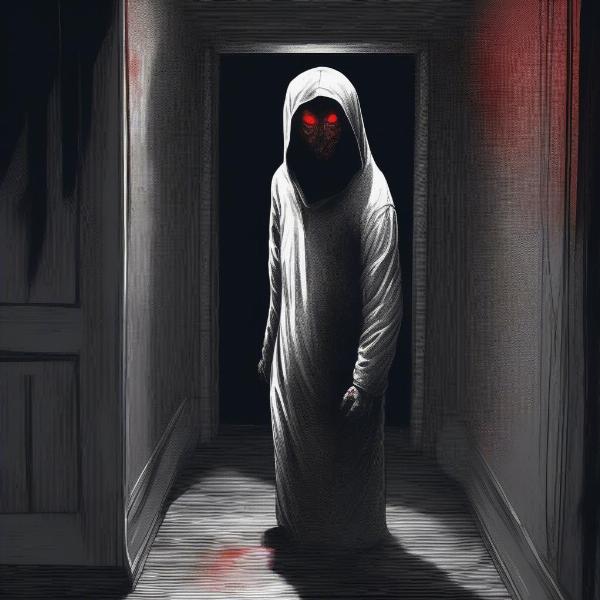Doors, the Roblox horror experience, has captivated players with its blend of puzzle-solving and jump scares. Its simple yet effective gameplay loop has sparked the creativity of many aspiring game developers. This article will delve into the core mechanics of Doors and provide a comprehensive guide on how to create a similar game.
Similar to the gameplay of how do you play the umbrella game, Doors relies on a sense of anticipation and surprise. The game’s success hinges on its ability to create tension and deliver unexpected scares, while still providing players with a sense of accomplishment as they progress. This guide will cover various aspects of game development, from conceptualization and design to programming and implementation, providing you with the tools and knowledge necessary to craft your own chilling experience. Whether you’re a seasoned developer or just starting out, this guide will equip you with the knowledge needed to bring your horror game vision to life.
Understanding the Core Mechanics of Doors
The magic of Doors lies in its simplicity. Players navigate a series of numbered rooms, each presenting unique challenges and lurking dangers. These challenges range from finding hidden keys and solving puzzles to avoiding entities and surviving sudden, terrifying events. The core loop is about exploration, puzzle-solving, and survival. Understanding this loop is crucial for replicating the Doors experience.
Key Elements of the Doors Gameplay Loop
- Exploration: Players explore interconnected rooms, each with its own distinct atmosphere and potential threats.
- Puzzle Solving: Progress requires solving various puzzles, from simple key hunts to more complex logic challenges.
- Survival: Avoiding entities and navigating hazardous environments are essential for survival. Quick reflexes and strategic thinking are key.
- Progression: Successfully completing rooms unlocks new areas and advances the narrative, adding a sense of accomplishment.
Designing Your Own “Doors” Experience
Creating a game like Doors requires careful planning and execution. Here’s a step-by-step breakdown of the design process:
- Concept and Theme: Define the core theme and atmosphere of your game. Will it be a haunted house, a derelict spaceship, or something else entirely?
- Room Design: Plan the layout and challenges for each room. Vary the puzzles and scares to keep players engaged.
- Entity Creation: Design unique and terrifying entities. Consider their behavior, appearance, and how they interact with the player.
- Progression System: Determine how players unlock new areas. Will it be through keys, puzzle solutions, or a combination of both?
Development Tools and Technologies
Choosing the right tools is crucial for bringing your game to life. Here are some popular options:
- Game Engines: Unity and Unreal Engine are excellent choices for creating 3D horror games.
- Programming Languages: C# (for Unity) and C++ (for Unreal Engine) are commonly used.
- 3D Modeling Software: Blender and Maya are powerful tools for creating detailed environments and characters.
- Sound Design Software: Audacity and FL Studio can help you create immersive and terrifying soundscapes.
Is your game as engaging as what time is it mister wolf game? Consider adding multiplayer or cooperative elements to enhance the experience.
 Doors Game Room Design Example
Doors Game Room Design Example
Programming the Game Logic
The core gameplay loop of Doors revolves around triggering events based on player actions. This involves scripting interactions with objects, managing entity behavior, and controlling the game’s flow.
Implementing Key Features
- Room Transitions: Code the logic for transitioning between rooms when the player interacts with doors.
- Puzzle Mechanics: Implement the functionality for puzzles, including triggering events, checking solutions, and providing feedback.
- Entity AI: Program the behavior of entities, such as their movement patterns, attack strategies, and reaction to the player’s presence.
- Sound and Visual Effects: Integrate sound effects and visual cues to enhance the atmosphere and scare factor.
Testing and Refinement
Thorough testing is essential for ensuring a polished and enjoyable experience. Playtest your game regularly and gather feedback from others. Pay close attention to:
- Gameplay Flow: Ensure the game’s pacing is balanced and engaging.
- Puzzle Difficulty: Adjust the difficulty of puzzles to provide a challenging but fair experience.
- Scare Effectiveness: Refine the timing and intensity of scares to maximize their impact.
- Bug Fixing: Identify and address any bugs or glitches that may affect gameplay.
Do you know how much is merlin game worth? Thinking about monetization strategies early on can help you plan for the future of your game.
 Doors Game Entity Design Example
Doors Game Entity Design Example
Polishing and Release
Once you’re satisfied with the core gameplay, focus on polishing the game’s presentation. This includes:
- Visual Enhancements: Improve the graphics and lighting to create a more immersive atmosphere.
- Sound Design: Add ambient sounds, music, and sound effects to enhance the horror experience.
- UI/UX Design: Create a user-friendly interface that is easy to navigate.
Expanding Your Game (Optional)
Once you have a solid foundation, consider expanding your game with additional features:
- Multiplayer: Allow players to experience the horror together.
- Procedural Generation: Create dynamically generated rooms for increased replayability.
- Storytelling: Develop a compelling narrative to enhance the game’s depth.
Frequently Asked Questions (FAQ)
What software is best for making a game like Doors?
Both Unity and Unreal Engine are good choices. Unity is generally easier to learn for beginners, while Unreal Engine offers more advanced graphical capabilities.
What programming language should I use?
C# is recommended for Unity, while C++ is commonly used for Unreal Engine.
How long does it take to make a game like Doors?
The development time varies depending on the scope and complexity of your game. A simple game could take a few months, while a more complex project could take a year or more.
Can I make a game like Doors on my own?
Yes, it’s possible to create a game like Doors solo. However, having a team can significantly speed up the development process.
How can I make my game scary?
Effective horror relies on atmosphere, sound design, and psychological elements. Focus on building tension, creating jump scares, and playing with the player’s expectations.
How do I publish my game?
There are various platforms for publishing games, including Steam, Itch.io, and mobile app stores. Each platform has its own requirements and submission process.
What are some common mistakes to avoid?
Common mistakes include poor planning, inadequate testing, and neglecting sound design. It’s also important to avoid overusing jump scares, which can become predictable and less effective over time.
Games like is fallout 76 a survival game demonstrate the appeal of survival horror. Consider incorporating similar elements into your Doors-inspired game.
Conclusion
Creating a game like Doors is a challenging but rewarding endeavor. By following this guide, you’ll have the foundation necessary to bring your own horror vision to life. Remember to focus on the core gameplay loop of exploration, puzzle-solving, and survival. With careful planning, dedication, and a passion for creating terrifying experiences, you can craft a game that will captivate and thrill players. Good luck, and remember to keep the lights on!

